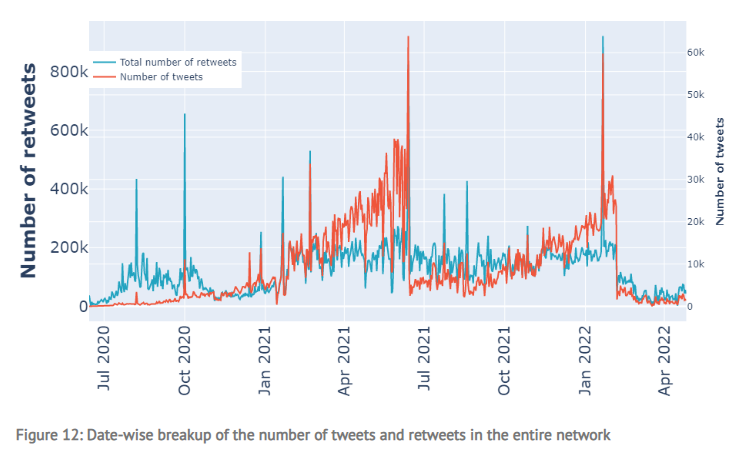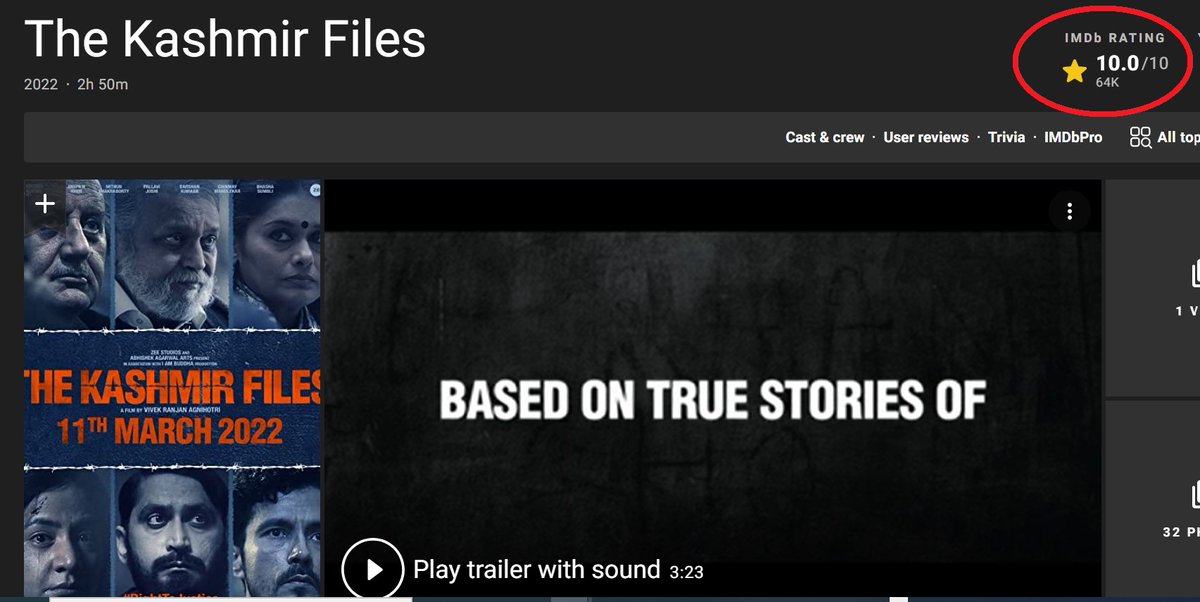
The consistent anti-Bollywood trending emerges from a group of dedicated Sushant Rajput fans whose networks, history & output give insight into the radicalization of online populations & organized trolling in India.
It's also a failure story of Twitter as a platform
Thread:
It's also a failure story of Twitter as a platform
Thread:

The community treats the death of Sushant in the same way that religious communities treat dogma. There can be no evidential argument on it. In this it is closer to the communities that spread theories about the death of Diana Spencer than typical online fan-clubs 

There are various people engaged in SSR tweeting. Some were fans before his passing, some came on after his death mid-pandemic, some simply distrust the government on other fronts and find a community with a common goal.
Each plays different roles in the conspiracy ecology
Each plays different roles in the conspiracy ecology
Social media activity from the core group of fans exhibits patterns akin an obsessive disorder, which is also seen fan worship around film stars, spiritual cult leaders etc.
Many online 'SSRians' spend entire working days simply tweeting about SSR.
en.wikipedia.org/wiki/Celebrity…
Many online 'SSRians' spend entire working days simply tweeting about SSR.
en.wikipedia.org/wiki/Celebrity…
There are profiteers, who engaged with SSR, gained followers and built digital careers and online influence.
A key influencer was @ErayCr, a digital marketer and early pusher of Disha Salian misinformation, who emerges as one of the fastest growing accounts from the SSR case.
A key influencer was @ErayCr, a digital marketer and early pusher of Disha Salian misinformation, who emerges as one of the fastest growing accounts from the SSR case.

The media profiteers are key to misinformation because of their clever use of innuendo. Peer-reviewed work published @acmcompass at #compass2022 shows @republic @timesnow were instrumental in headlining the story and pushing conspiracy theories.
Link:
dl.acm.org/doi/10.1145/35…
Link:
dl.acm.org/doi/10.1145/35…

The community follows a pyramid structure, a small set of accounts decide what is to be retweeted, and that is aggressively pushed daily. The strategy is similar to political parties, but also others who have gamed Twitter, including @Gurmeetramrahim
A misinformation community also typically has a few large-scale influencers who gently nudge an issue.
In the SSR case, this was @swamy39 who had over 85 tweets that were retweeted over 650k times overall on SSR-related messaging.
He even advertised hashtags on placards.
In the SSR case, this was @swamy39 who had over 85 tweets that were retweeted over 650k times overall on SSR-related messaging.
He even advertised hashtags on placards.

Other influencers, less complicit as @swamy39, also contribute to misinformation – these include @sonusood @akshaykumar who asked for CBI probes. Actor @Simi_Garewal was key in spreading lies about Disha Salian.
These influencers matter they help mainstream the narrative.
These influencers matter they help mainstream the narrative.

Early SSR theories were fueled by politicians & their "friendly media" to attack @AUThackeray by referring to him as #BabyPenguin and claiming he had something to do with the murder.
Over time, these became part of a general anti-Sena narrative.
These continue till date.
Over time, these became part of a general anti-Sena narrative.
These continue till date.

Past work showed politicians drove a “murder” narrative, even when the initial conversation was about suicide and mental health. Bihar politicians in particular, got high engagement on it. 

All the influential accounts that tweeted about SSR also stopped engaging the subject by October 2020. This is also when the bots scandal was exposed and showed political complicity. Rhea Chakravarty was released a day later. 

Swamy’s role in tweeting about SSR also underlines his success with getting off a movement as it wanes.
We see here that Swamy stops tweeting about SSR, more or less as soon as the average retweet values start falling.
We see here that Swamy stops tweeting about SSR, more or less as soon as the average retweet values start falling.

By Oct 2020, mainstream media, incl. news sources that were covering the issue aggressively stop covering it.
By this point, the SSR community turns totally inwards, even @TimesNow was accused of being in an anti-SSR conspiracy.
This is a key turning point in radicalization.
By this point, the SSR community turns totally inwards, even @TimesNow was accused of being in an anti-SSR conspiracy.
This is a key turning point in radicalization.

Now here are some network characteristics of the SSR community that are useful in understanding other similar misinformation or propaganda communities
There are a number of accounts with alternate handles. This is because the handles expect to be banned for trolling or other forms of platform prohibited activity. An alternate account is a good sign that an account is engaged in trolling, astroturfing, or misinformation. 

We examined a core SSR community – most activity traces back to a small number of handles. They are in a very tight-knit network
Of 151 handles we ran through botometer, 150 were above the threshold of being bots. Even though some weren't, they tweeted enough to seem like bots
Of 151 handles we ran through botometer, 150 were above the threshold of being bots. Even though some weren't, they tweeted enough to seem like bots

Essentially, some accounts tweet so much that any bot analyzer would find their activity unreasonable for a human person, two-thirds of the core accounts tweeted over 100 times daily, one third were above 200 tweets daily. Several maxed at over 2000 tweets daily. 

The same high-frequency tweeters also have 0 tweets on various dates, and then suddenly spike to tweet a lot, and then again go back to not tweeting.
This too is a sign of platform exploitation.
This too is a sign of platform exploitation.

here are sudden drops in activity, usually precipitated by bans. An example of this happens immediately after a massive spike in activity on June 14, 2021 

The spikes in activity are very closely planned. A core account tells people to prepare to tweet. Then a list of main and alternate accounts are set up, then all these coalesce to send tweets with a block of text multiple times daily. 

The block of text, referred to as a tagline, can be put out multiple times by a single account and reduces reliance on bots. They differ from hashtags, they appear as trending text differently, and are not as obvious to catch as spurious activity 

Low-level influencers trigger a tagline, a second layer of followers swings into action.
An SSR community leader offers updates to keep the troops engaged.
An SSR community leader offers updates to keep the troops engaged.

On to conspiracies
We classified the conspiracy theories found in the SSR community into "epistemic", "existential", and "social" drivers of misinformation. Research shows that during crisis periods, acceptance of conspiracy theories spikes.
(full paper)
joyojeet.people.si.umich.edu/dogma/
We classified the conspiracy theories found in the SSR community into "epistemic", "existential", and "social" drivers of misinformation. Research shows that during crisis periods, acceptance of conspiracy theories spikes.
(full paper)
joyojeet.people.si.umich.edu/dogma/
The co-occurrence of COVID is likely a major driver of the continuing engagement in misinformation about SSR’s death, but the slow progress with the case, despite several clean chits from investigation agencies suggests that institutions have allowed this community to thrive.
Epistemic drivers relate to the inability to make sense of an event. The lack of clear resolution drives misinformation, people want to be able to explain what is going on. Innuendo by accounts like @swamy39 were critical in pushing up conspiracy theories 

Existential drivers relate to fears about of future, based on identity - thus of systematic discrimination, being made outsiders etc. These tweets focus on the notion of the difficulty for making it in Mumbai for ‘outsiders’ and how the odds are stacked against common people 

Social drivers relate to engaging in misinformation because it aligns with one’s social worldview. Here, one attempts to show oneself, or one’s social group as superior by proposing misinformation about another 

The SSR community “leadership” is often in flux, despite their ability to make things trend. The community trends Sameer Wankhede, the NCB officer who shot to fame for his role in the Aryan Khan case, and has been linked to an SSR leader 

However, their radicalization, and ties to other forms of misinformation are here to stay. New Bollywood film are attacked, as are individual stars after major events
The most important outcome of the SSR crisis is just how easy it is to game the Twitter algorithm, and how weak our current information ecosystem is in combating misinformation.
This is work by Anirban Sen and myself, a link to the full paper is here:
joyojeet.people.si.umich.edu/dogma
This is work by Anirban Sen and myself, a link to the full paper is here:
joyojeet.people.si.umich.edu/dogma
• • •
Missing some Tweet in this thread? You can try to
force a refresh














